As part of the celebration of the 70th anniversary of Topps baseball cards, we've asked fans (as well as our staff) to submit their all-time favorite baseball cards, and we've broken them down by team. We'll be revealing submissions regularly throughout the season, ranging from the famous to the weird, and everything in between.
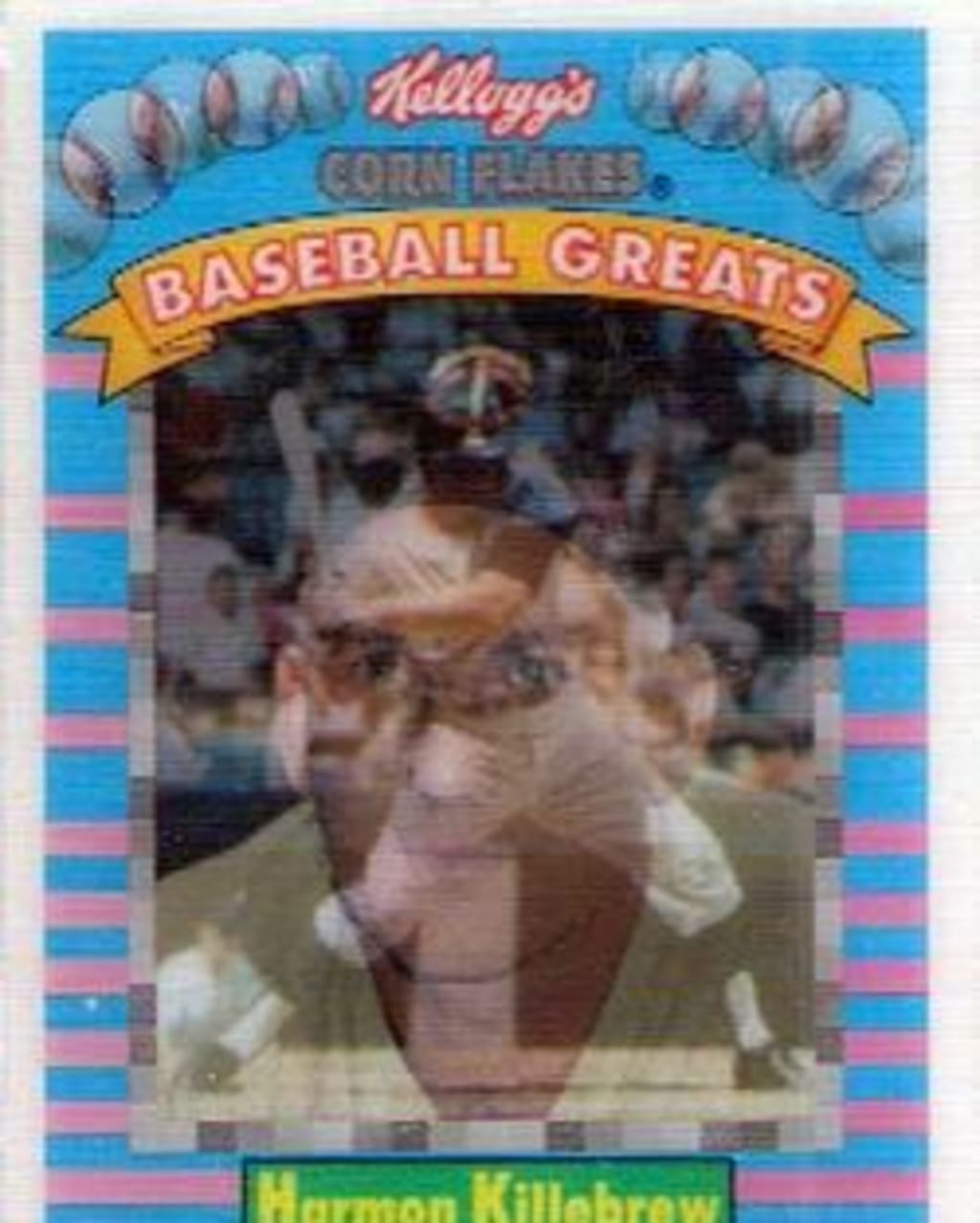
Harmon Killebrew, 1991 Kellogg's
You know you’ve got something special when you’ve got an all-time great on a card from Kellogg's -- these are always fun, coming out of the cereal box with great anticipation. The card itself is tremendous, with “Kellogg's Corn Flakes Baseball Greats” at the top and a great photo of the slugging Harmon Killebrew mid-swing -- Killebrew belted 573 home runs over a 22-year Hall of Fame career, spent almost entirely with the Twins franchise.
And that’s not all -- these cards were holograms, with the photo changing as you moved the card. Greg O. submitted this card in our survey and has a very special reason for doing so.
“I treasure this card because it was given to me by my father, and because Harmon was my favorite Twins player growing up rooting for the Minnesota Twins,” he wrote. -- Manny Randhawa
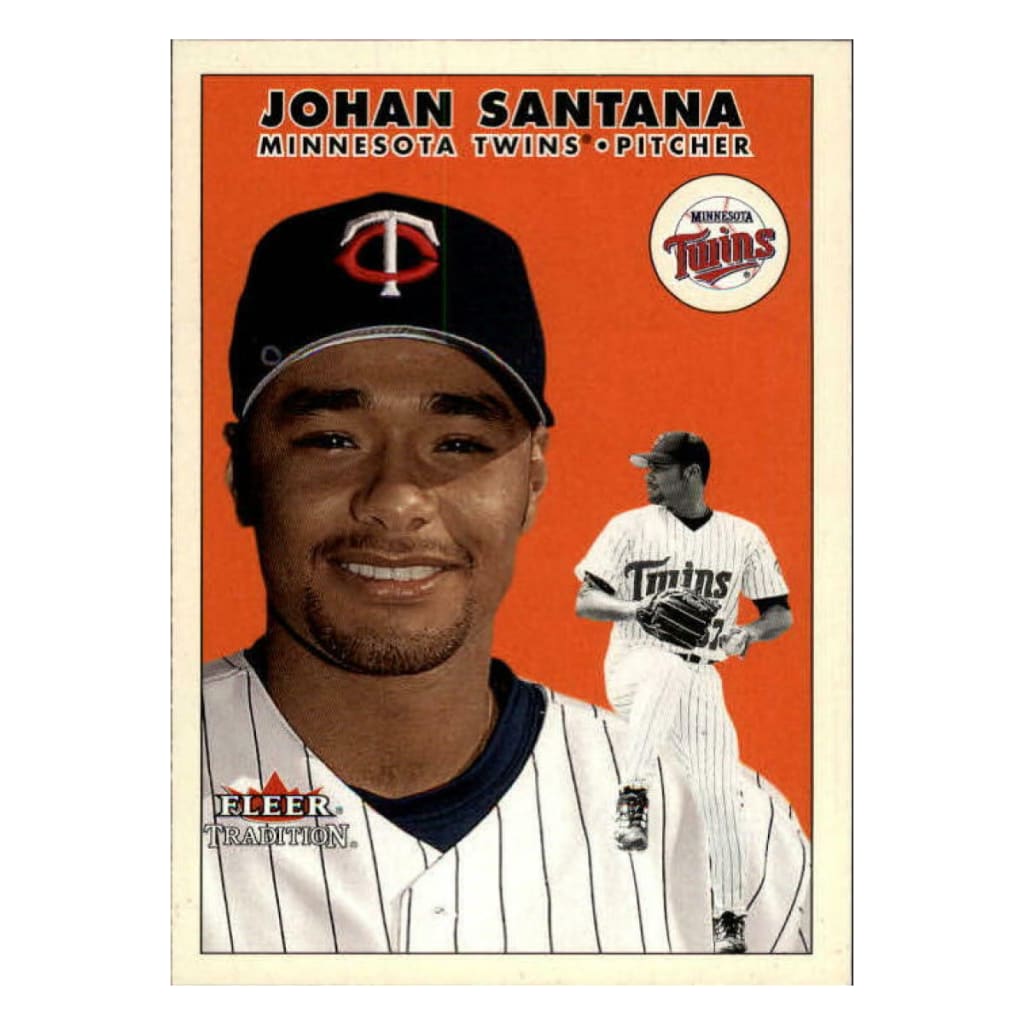
Iconic Twins rookie card: Johan Santana, 2000 Fleer Tradition
What a great-looking card for one of the most dominant aces of his generation.
Johan Santana was sporting his signature goatee even as a 21-year-old in 2000. The headshot on his Fleer rookie card captures that -- and comes with the added bonus of an inlaid shot of the southpaw in the middle of his delivery.
He went on to win two American League Cy Young Awards in Minnesota, in 2004 and '06, and he won an MLB pitching Triple Crown in the latter year by leading the Majors with 19 wins, a 2.77 ERA and 245 strikeouts. He was simply the best pitcher in baseball at his peak.

Kirby Puckett, 1993 Topps
Kirby Puckett’s '93 Topps card, which depicts the Hall of Famer with a giant novelty Louisville Slugger bat, was a popular submission. Cody Christie of West Fargo, N.D.; John Elliott from Albany, Minn.; Josh Lunt from Sioux Falls, S.D.; and Steve Thompson from Minneapolis all picked it in our survey.
Puckett was only 5-foot-8, but his bat packed a big punch, providing extra meaning to the image on the card. The Twins center fielder produced 20-plus homers six times in 12 seasons and finished with a slash line of .318/.360/.477 with 207 homers and 414 doubles.
“The photo of Puckett with a giant bat provides a perfect juxtaposition,” Christie wrote. “He was a little man that carried a big stick all the way to the Hall of Fame.”
“It’s one of my favorite players in a ridiculous pose with a massive bat, it’s absolutely perfect,” wrote Elliott.
“Huge Twins fan here; thought this card was amazing when I was 12 years old!” Lunt wrote. “Kirby was already a hero from the 1987 and 1991 World Series for me, but this card expressed what we all thought -- Kirby was like a baseball giant who swung a giant bat! Combined with his killer smile, it was just a card that always comes to mind!”
“Kirby Puckett was my favorite baseball player of all time and a Minnesota legend,” wrote Thompson. “His two World Series titles and his big home run in Game 6 of the 1991 World Series place him as the greatest Minnesota Twins legend of all time. He was a small man with a big bat and big heart!” -- Thomas Harrigan
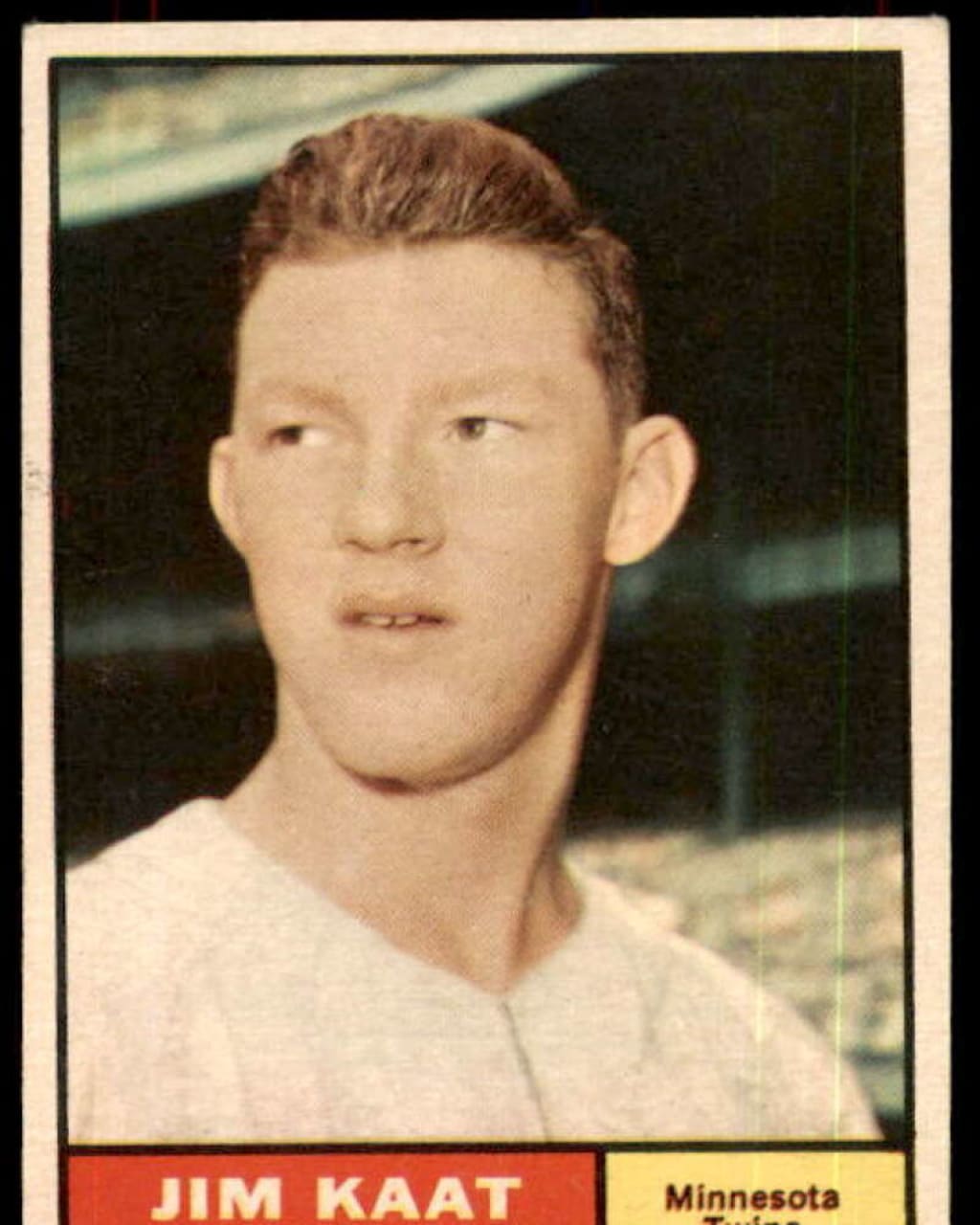
Jim Kaat, 1961 Topps
If there was ever a “Wonder Years”-type of baseball card story, it’s this one. It’s just tremendous. Only the man who pulled this Jim Kaat card out of the first baseball card pack that he ever opened could tell it best:
“I have to admit, my first purchase of baseball cards was not all roses,” wrote Bill H. of Jacksonville, Fla. "There was a rough patch mixed in, a real-life learning experience for a 7-year-old kid from the projects. Nope, it was not all fun and games, not by a long shot. I live in Jacksonville these days, but I grew up in Ogdensburg, N.Y., a small city situated on the St. Lawrence River atop New York state. That was where baseball cards were -- the only place in the country, according to my brother Ted, that they were sold. How fortunate I felt to live just a few blocks from 'The Store.' Life was good.
“I spent the winter of 1960-61 planning for my first-ever purchase. Not only was this going to be my first purchase, I was making it with my own money -- hard cash earned from my first job shoveling snow. The day finally arrived. I would make my first purchase of two 1961 Topps baseball card packs from Boosey Blair's store. It was a tiny place, couldn't have been much larger than a 12' x 10' room attached to the back of Boosey's house.
“He let me pick out which packs I wanted. I figured they hid the best ones at the bottom of the box, so I went for two that were deep inside. The packs were bright red if I am remembering correctly. Or they may have been green. Anyway, I slid a few coins toward Boosey and he slid one back with the packs. I stood silently holding the two packs of cards for what I guess was a long time since Boosey asked me twice if there was anything else I wanted, and then if I was feeling OK. I don't remember moving, but the next thing I knew, I was outside his store, still staring at the two packs of cards. That's when it occurred to me that I didn't know if there was a proper way of opening the packs. Ted had shown me his cards the prior summer and they were just loose, bouncing around in the bottom of an old shoe box. I was taken aback by the packaging. I had not anticipated this. I took them home, unopened. I considered asking Mom what to do, but decided I could figure it out. I mean, I was 7, after all. I had planned on opening them slowly, carefully, but excitement got the better of me and I tore the paper off pack number one. Jim Kaat's card was at the top of the pile. I'd never heard of him, but he was my first-ever baseball card and he instantly became my favorite player.
“Two thoughts raced through my head: He was so pale, he looked like a ghost. And second, they spelled his name wrong. Kaat does not have two a's. I guess I was OK that they spelled ‘cat’ with a K, but the two a's I was having none of. Then pack number two. A definite learning experience. I might have only been 7 years old, but after what I discovered opening pack number two, I felt older and wiser, like I was 10. I was calm opening pack two, more experienced I guess. I removed the paper and thumbed through the cards … that's when I saw him, staring back at me. A second Jim Kaat card, identical to the first one. I suddenly realized I didn't own the only one, and as it turned out, there were multiple cards of every player. I had no idea. But now I do. That's why they call them trading cards.”
-- Manny Randhawa
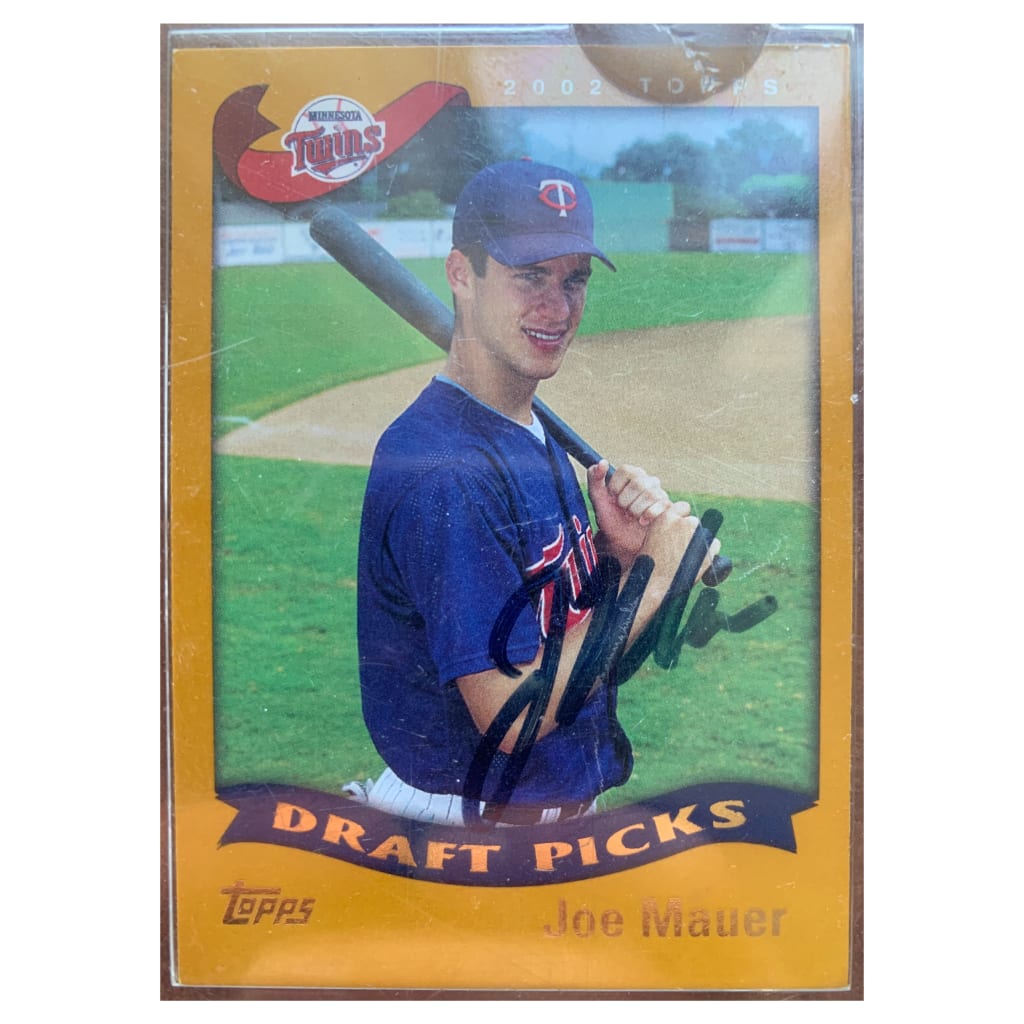
Joe Mauer, 2002 Topps Draft Picks
What's better than a Joe Mauer rookie card? A signed Joe Mauer rookie card.
Twins fan Tom S. of Minneapolis sent in this 2002 Mauer Topps Draft Picks card, which he got Mauer to sign at TwinsFest that very same year. Minnesota had just made the local kid Mauer the No. 1 overall pick in 2001 out of St. Paul's Cretin-Derham Hall High School.
Mauer went on to play his entire 15-year career with the Twins, and he became one of the greatest catchers of his generation, if not all time.
The sweet-swinging lefty amassed 2,123 career hits with a .306 lifetime batting average, and he won the 2009 American League MVP Award and three batting titles.
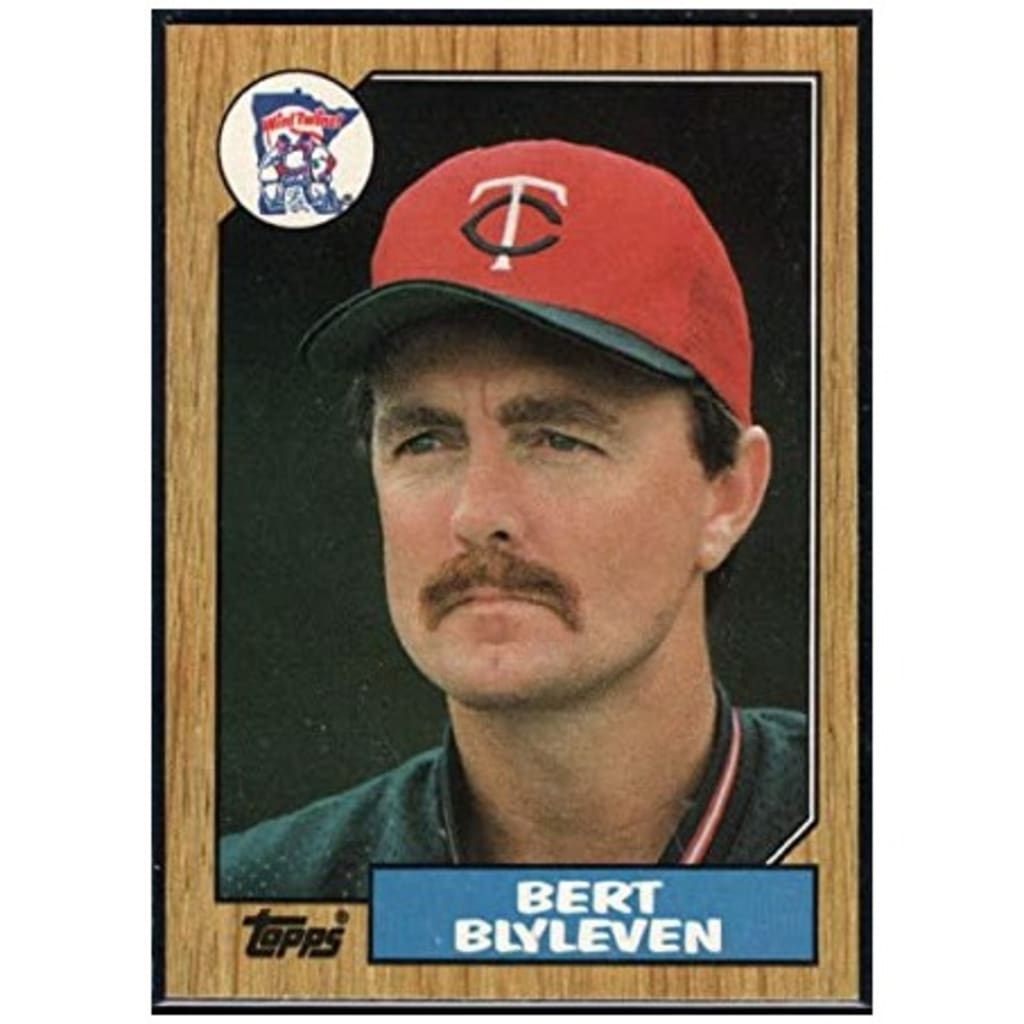
Best Twins facial hair card: Bert Blyleven, 1987 Topps
Bert Blyleven was a chameleon during his Hall of Fame career, not only playing for five different teams but also frequently changing up his look.
Pitching for 22 seasons, the ginger-haired righty was a clean-shaven 19-year-old as a rookie in '70. Over time, the Netherlands native dabbled with a mustache, bushy sideburns and multiple beard lengths.
His 'stache was presented in all its glory on his '87 Topps card, with Blyleven looking more like a Minneapolis-area high school math teacher than a pitcher who had 215 K’s the previous season. -- Thomas Harrigan
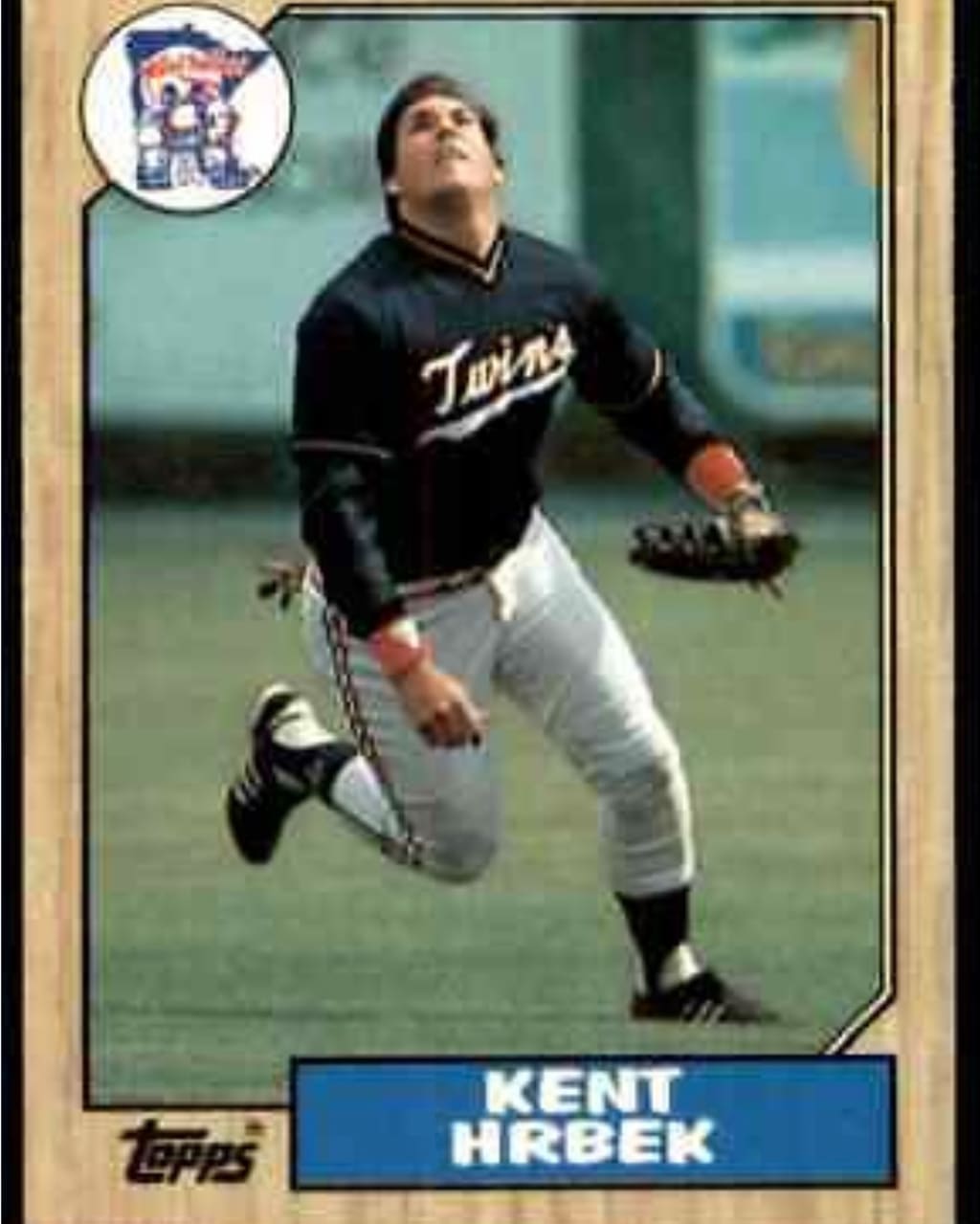
Kent Hrbek, 1987 Topps
Kent Hrbek will always be remembered as one of the key players in the Twins’ golden era in the late 1980s and early 1990s, when Minnesota won two World Series titles in the span of five seasons. He was an underrated slugger in his day, slashing .282/.367/.481 with 293 home runs in 14 seasons, all with his hometown Twins -- he was born and raised in Minnesota.
Interestingly enough, this 1987 Topps card shows Hrbek chasing a popup with his hat already having flown off his head. Not exactly his forte in the game, which was mashing home runs, but check out the sweet Spring Training jersey with the cursive script on the front, a classic in the franchise’s history.
Jesse D. of Princeton, Minn., will never forget watching Hrbek’s heroics in the 1987 World Series, when the Twins defeated the Cardinals in seven games.
“A small-town, homegrown kid turns into World Series champion for his local team,” Jesse wrote in his survey response. “His grand slam in Game 6 still gives me chills to think about, even more so than 6-year-old me watching it live.” -- Manny Randhawa

David Ortiz, 1997 Fleer Ultra
This is such a cool card of David Ortiz, showcasing the humble beginnings of Big Papi.
Just look at the name: "David Arias," in shimmering silver and red across the lower portion of the card. This is David Ortiz before he was even David Ortiz, let alone Big Papi, one of the greatest designated hitters of all time.
It's his rookie card, from when he was just 21 years old and making his MLB debut with the Twins. Ortiz hit only one home run in his 15-game cup of coffee in 1997, and 58 in total in his six seasons in Minnesota. Then he went to the Red Sox, and the rest is history: 541 career home runs, three World Series rings and icon status in Boston.
The card is a submission from fan Brian D., who likes it "simply because I haven't seen many of these cards, and because it's the beginning of a historically great player."
Even if you didn't know Big Papi's story, this is a great-looking card. Ortiz is holding his bat across his back like a lumberjack holding his ax, his signature grin on his face as he displays the red Twins logo across the front of his white pinstriped jersey.

Bert Blyleven, 1975 Topps
Topps went with a colorful design for its '75 set, with two-tone borders and team nicknames presented in a bold, drop shadow font atop each card.
For most of the cards in the set, the border and team colors don't match. But the blue-and-red border on Blyleven’s card perfectly syncs up with his Twins uniform as he takes in the action from the dugout, mid-bubble.
The card was submitted by Mike Siebenaler, who wrote:
“Bert has been a fan favorite and a hero of mine. He had the best curveball in the history of baseball, and he was a first-class prankster. He was fun, and we all knew it. When he was a broadcaster, he shared all of his stories and prank tips. This bubblegum card captures his fun side. I always had it in a card sleeve on my wall. Blyleven looks as cool as Rod Carew stealing home on this card.”
By '75, Blyleven was an established ace for the Twins, having recorded a 2.74 ERA with 1,094 strikeouts in 1335 2/3 innings over his first five seasons. After another strong year, Blyleven was traded to the Rangers in June 1976. He went on to pitch for the Pirates and Indians before making his way back to the Twin Cities during the '85 season.
Blyleven helped the Twins win their first World Series in '87 before finishing his career with the Angels. He ranks fifth in MLB history with 3,701 strikeouts. -- Thomas Harrigan
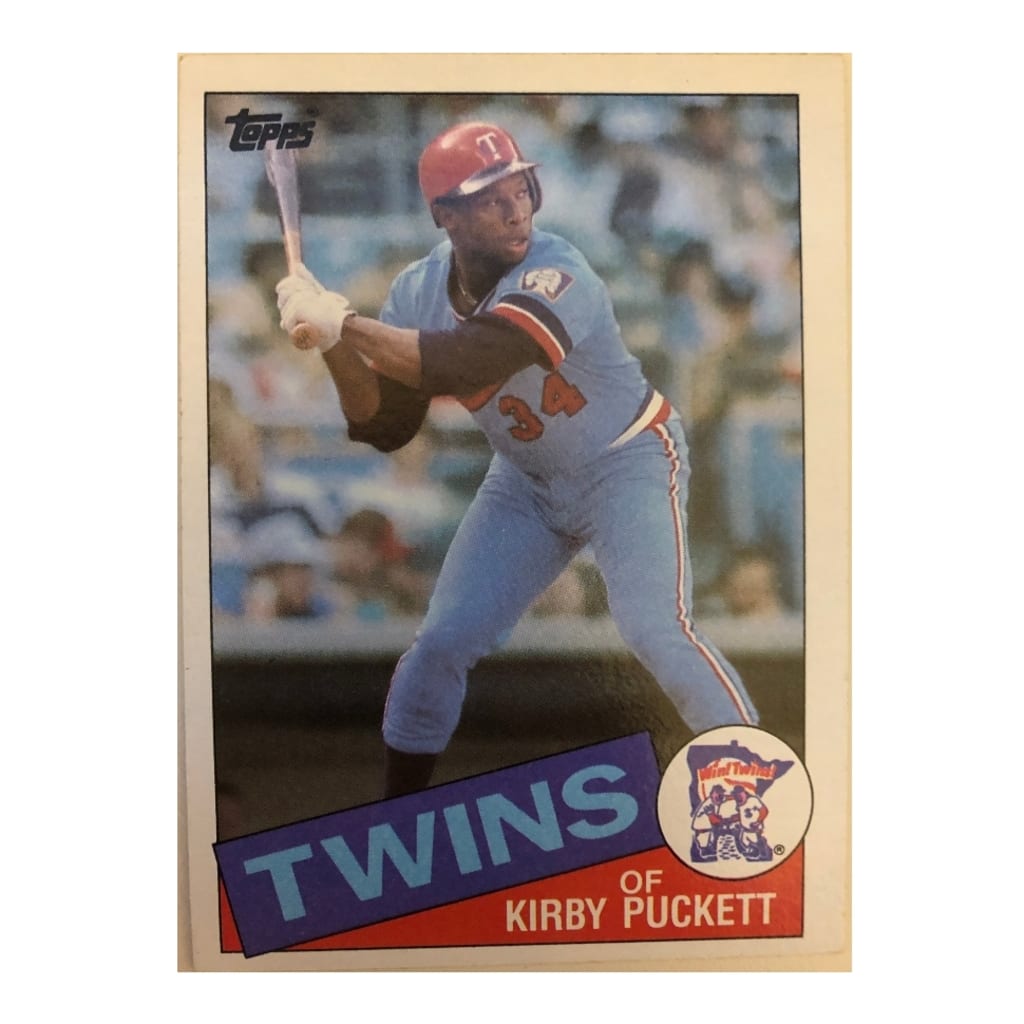
Iconic Twins card: Kirby Puckett, 1985 Topps
This was a popular submission, which isn’t surprising considering Puckett rose to prominence at the height of the golden age of baseball card collecting in the late 1980s and became one of the greatest players in Twins history.
“Having a 1985 Kirby Puckett rookie card for a kid growing up in the Twin Cities was like a kid owning a Mickey Mantle card in the '50s,” wrote Matthew Skovra. “From the moment Puckett began patrolling the outfield at the Metrodome, families would name their new puppies Kirby and kids in their backyard sandlot ballparks would imitate Puckett's high leg kick hitting style and practice robbing homers off the neighbor's garage.”
Selected third overall by the Twins in the 1982 MLB Draft, Puckett debuted two years later. The 5-foot-8 speedster made an immediate impact in the field, but he took a few years to develop into a powerhouse at the plate, eventually blossoming in '86 with a .328/.366/.537 slash line and 31 homers in 161 games.
Before his career ended prematurely due to an eye ailment, Puckett posted a .318 average with 2,304 hits, 207 homers, 1,085 RBIs, 1,071 runs and an .837 OPS in 12 seasons. He also won six Gold Glove Awards and helped Minnesota bring home two World Series crowns, in 1987 and ’91.
"Kirby was my dad’s favorite player growing up and an inspiration for all short baseball players [like me]," wrote Jack Lockart of Shelbyville, Ill. "The Twins old uniforms and logo are extra cool too."
Another submission came from Art Czepczynski of Duluth, Minn., who wrote:
“I immigrated to the U.S. as an 11-year-old kid in 1988 from Poland. I found out that some local team had won the World Series. I had no idea what baseball was, but I was curious about it when it came on TV. In 1990, my school took a trip to the Metrodome in Minneapolis and I realized this was the place that I was seeing all the games on TV. I learned the sport and I was hooked on baseball. The definitive Twin was Kirby Puckett, and watching him in the 1991 World Series solidified my love for baseball, the Twins and Kirby Puckett. I've had this card since I was a young kid.”
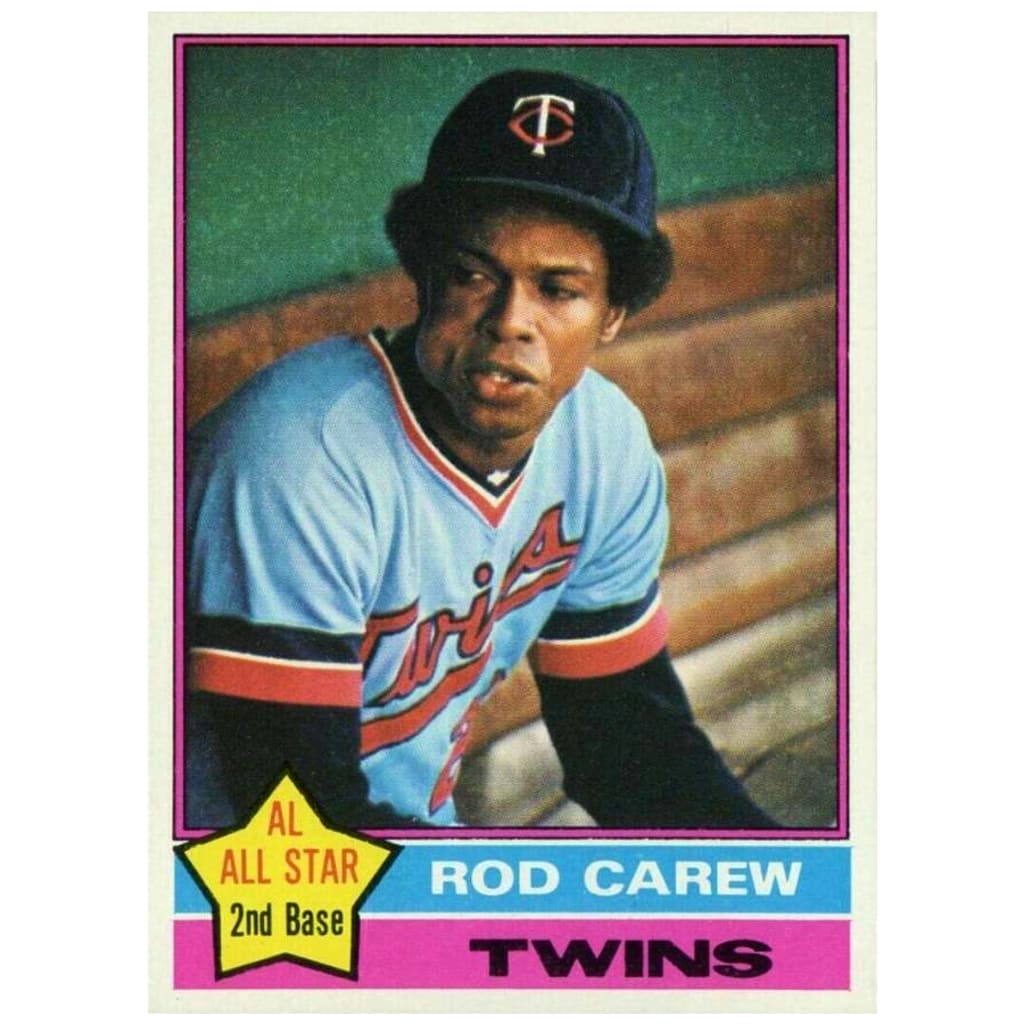
Rod Carew, 1976 Topps
Carew was an 18-time All-Star, so it's no surprise that this card proclaims it in bold letters inside a giant yellow star underneath Carew in a powder-blue Twins uniform.
Murray Vassar of Tampa sent it in, writing: "Rod Carew’s 1976 Topps cards is one of my favorites. I like the design of that year and Rod Carew is a legend. It’s a very colorful, understated card."
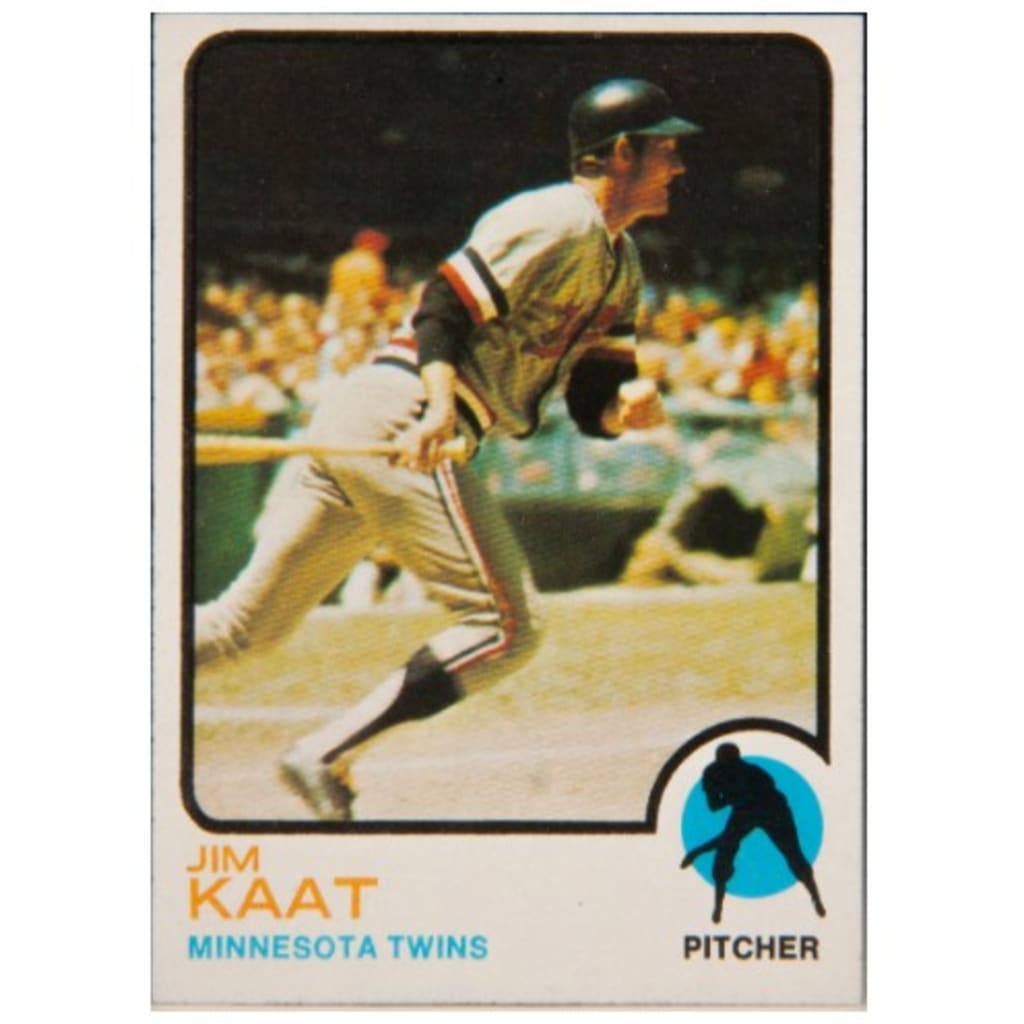
Jim Kaat, 1973 Topps
Kaat had a 25-year career as a pitcher, but for some reason, Topps opted to go with a picture of him batting on his 1973 card.
Granted, Kaat did have one of his best hitting seasons in 1972, as he posted a .289 average with two homers and a .793 OPS in 47 plate appearances, but it’s still an unusual photo selection.
“I also don't recall ever seeing any pitcher batting on their baseball card,” wrote Keith Lennon Sr. of Manchester, N.H., who submitted this card in our survey.
Another reason the card is notable? Because the picture presumably was snapped in 1972, the last season before the American League adopted the designated hitter. -- Thomas Harrigan

Joe Mauer, 2020 Topps Museum Series Collection -- Autograph 7/50
Talk about a rare jewel of a card -- there are only 50 of these in existence, so if you pulled this one from a pack, you hit the jackpot. Mauer is, of course, the greatest catcher -- and one of the greatest hitters -- in Twins history, and this insert is not only autographed by the man himself, but also has pieces of a game-worn jersey on it.
And talk about luck on a guy's side -- Brandon V. of Dodge Center, Minnesota submitted this card, and it's not the only valuable piece of Mauer memorabilia in his possession.
"I put this card in the bat case with the autographed Joe Mauer bat my wife won on the Twins Facebook giveaway on New Year's Eve," Brandon wrote.
Hope he bought a couple of lottery tickets, too. -- Manny Randhawa
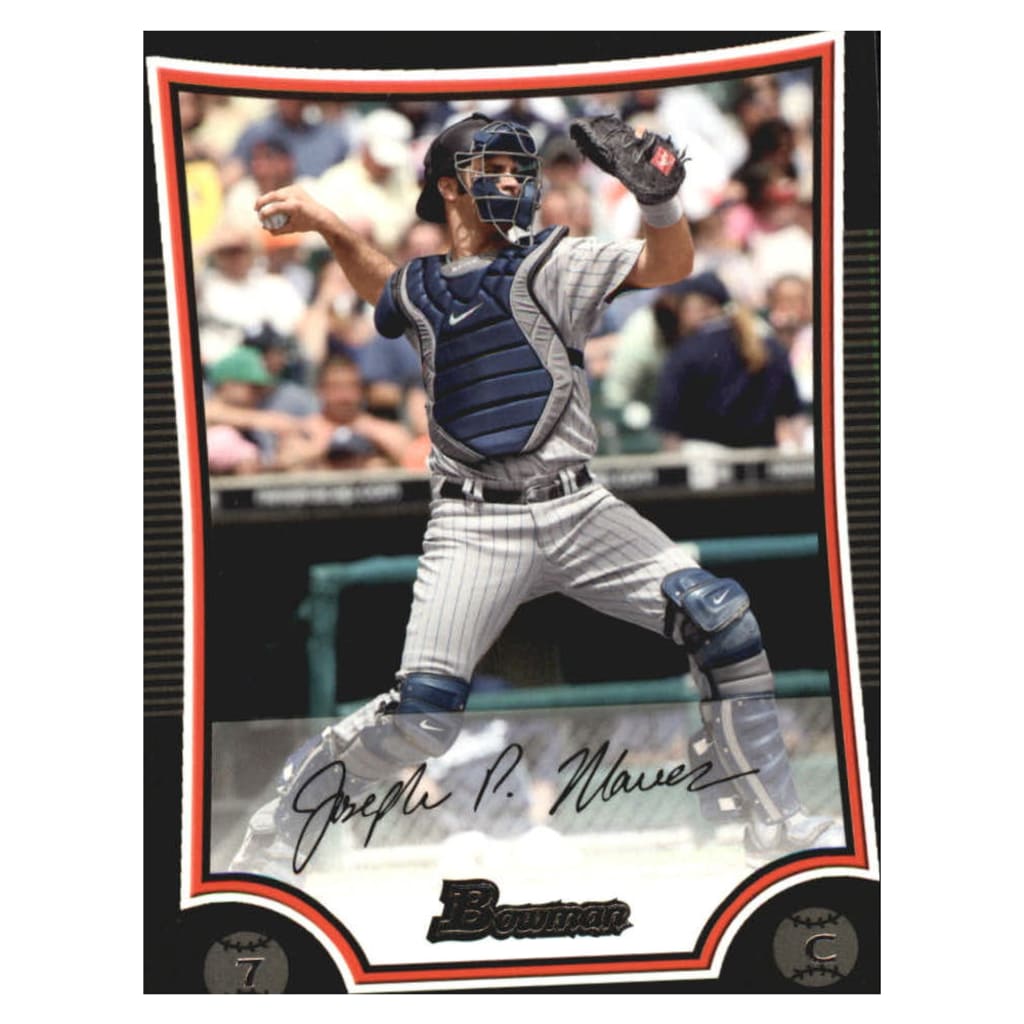
Joe Mauer, 2009 Bowman
The photo of Mauer on his '09 Bowman card is a highlight, as it captures him mid-throw from behind the plate, no doubt about to catch a runner trying to steal. It's a cool shot to see of one of the greatest catchers of his era.
In 2009, Mauer put together one of the best all-around seasons in recent memory. He won the MLB batting crown by hitting .365, belted 28 home runs, won a Gold Glove and Silver Slugger Award at catcher and was named AL MVP.
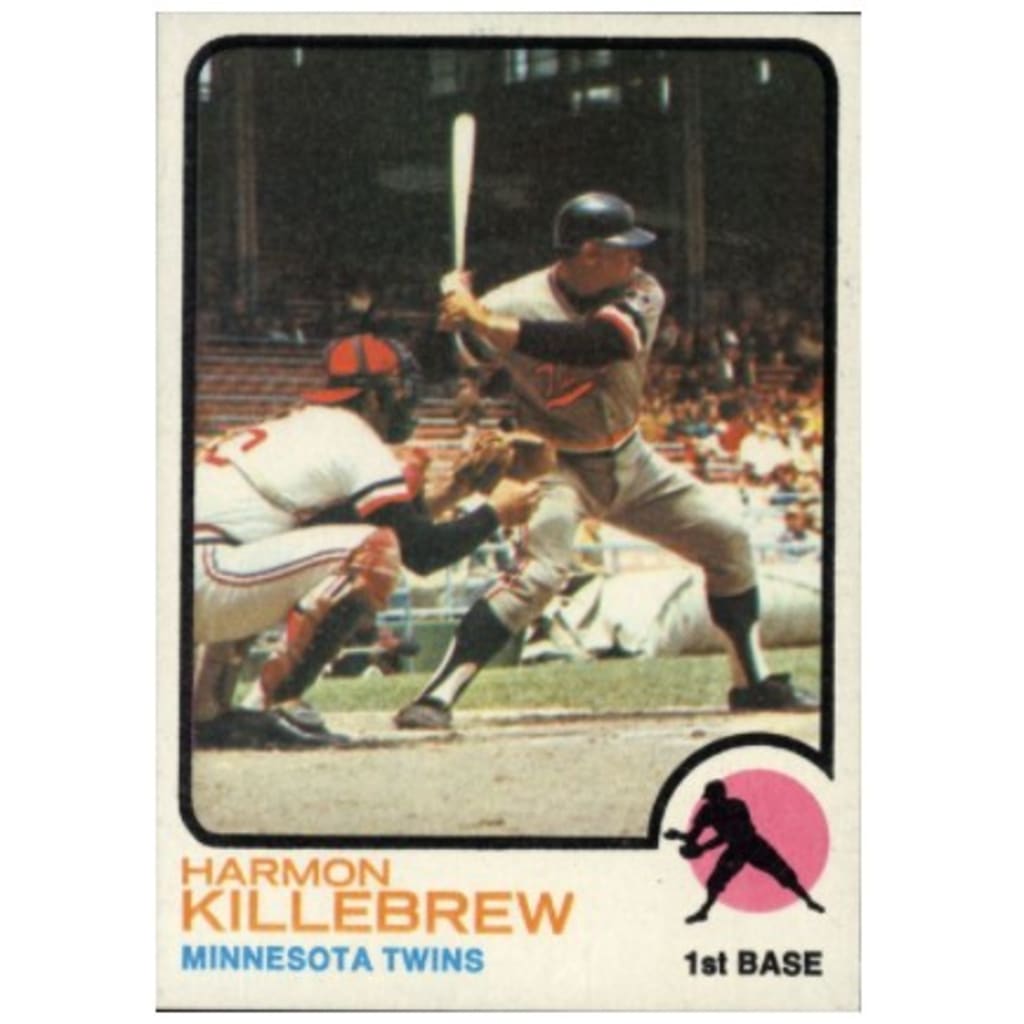
Harmon Killebrew, 1973 Topps
Killebrew was one of the top sluggers in baseball history, leading the AL in homers six times and finishing his career with 573 long balls.
This card from late in Killebrew’s career shows the Twins first baseman in action, preparing to unload on a pitch. It was submitted by Keith Hooper of Woodstock, Ga., who wrote:
“I remember it as one of the first ‘game action’ cards that I ever saw. It is such an awesome photo that allows the owner to gain a first-hand view of an up close game moment.” -- Thomas Harrigan
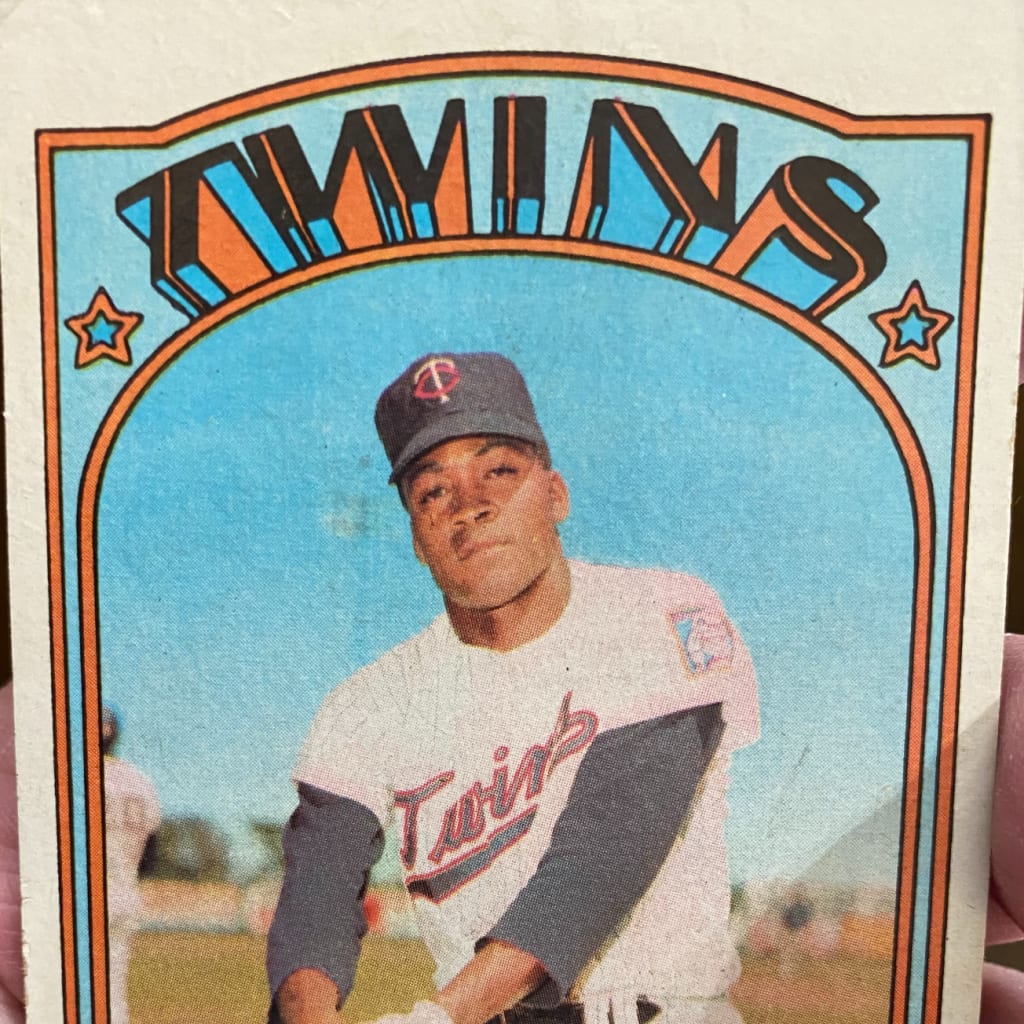
Cesar Tovar, 1972 Topps
It’s pretty cool to have a baseball card of a superstar player. But it can be just as great to have a card of a guy many people may never have heard of, but who was special to you.
That’s the case with this Tovar card from 1972, which was submitted in our survey by Mike S. of Minneapolis.
“Tovar was, and still is, a favorite Twins player for my parents and grandparents,” Mike wrote. “I still hear about the historic game in 1968 when he played all nine positions. I appreciate his versatility but I like the card because he looks like a superstar -- he has an attitude and one glove on his hands.
“Without using any words, Tovar is saying ‘I can hit anything and I can catch everything.’ Topps always assigned the top seven players with card numbers 100, 200, 300, etc., while the ‘good, not great players’ received the ‘5’s.’ Cesar Tovar was a ‘00’ player to my family.”
Tovar had a solid 12-year Major League career as both an infielder and an outfielder. He spent the majority of his career with the Twins, from 1965-72. Overall, he hit .278/.335/.368 with 226 steals. -- Manny Randhawa
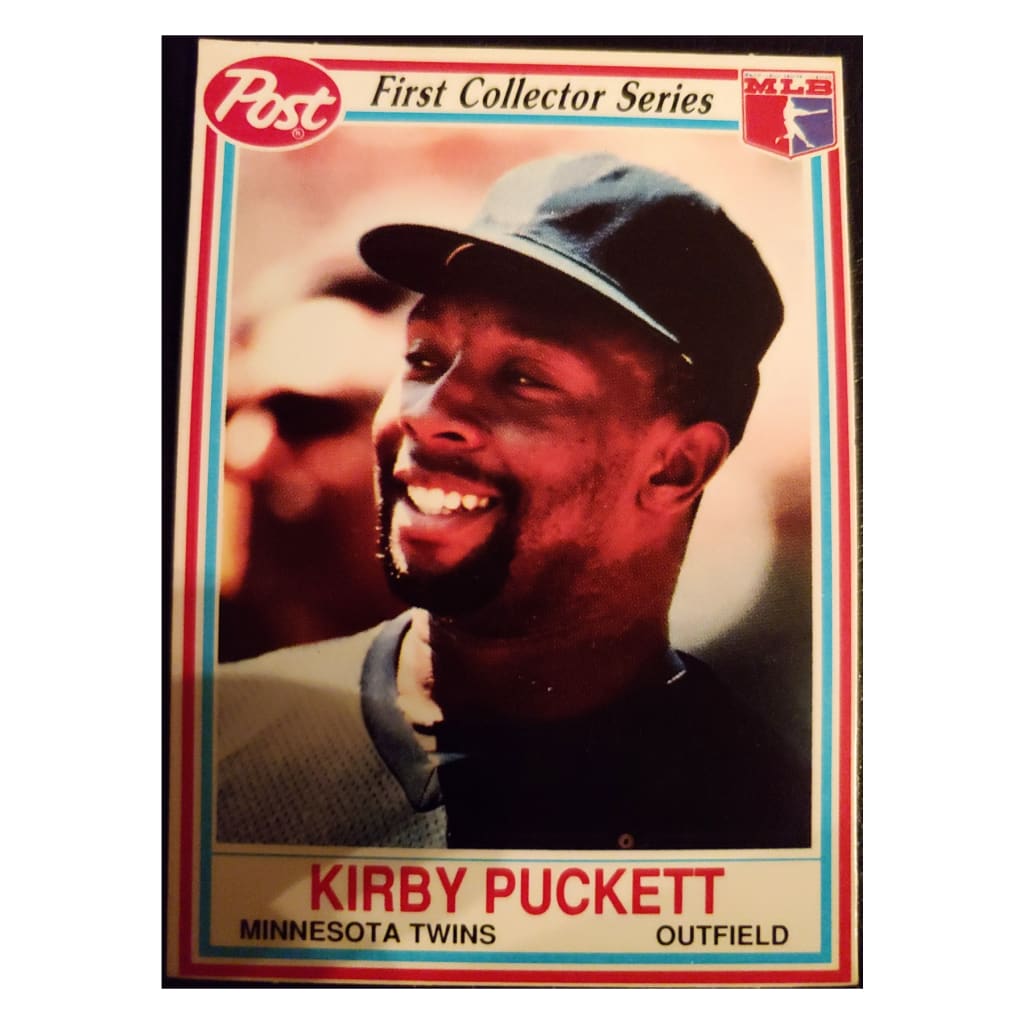
'90s throwback: Kirby Puckett, 1990 Post Cereal Cards
In 1990, the Post Cereal brand launched a series of baseball cards, featuring 30 of MLB's biggest stars. One of those was Puckett.
This card was a submission from fan Klint Ferrell of Malvern, Ohio, who writes: "The 1990 Post Cereal Kirby Puckett was my first card ever. I was super proud of it. Then when my dad told me he was a great player, I was really happy as I got older and saw how great Kirby was."

Rod Carew, 1968 Topps
Jonathan Venner of San Antonio, Texas, opened his first pack of cards at age 6 after winning it as a prize from a game at a classmate’s birthday party in 1968.
“One card stood out for obvious reasons,” Venner wrote. “That trophy had to mean this guy was special. I didn't know what a rookie was, nor did I know who the Twins were. Growing up in Toledo, Ohio, the newspaper covered the Tigers, the Indians and the Reds, and I knew my dad's favorite team was the Yankees. My grandfather loved Al Kaline, and my dad loved Mickey Mantle. But now I was officially a baseball fan, and I had Rod Carew. That card was constantly in my possession, and as a consequence, it became creased from my pockets, and the corners became soft and curved from all the handling."
According to Venner, he eventually moved on from collecting and sold whatever cards he had left in his closet, including the 1968 Carew, for $10. Years later, his interest in cards returned, but he never came across another 1968 Carew card, until ...
“I eventually shared the story of the Rod Carew card with my wife, and on my 30th birthday, I opened an envelope from her, and pulled out a beautiful 'new' 1968 Carew that she had bought at a card shop. A very special gift from a very special person. Ironically, we discovered some time later that my wife was born on the same day that Carew made his MLB debut. Circle completed.” -- Thomas Harrigan
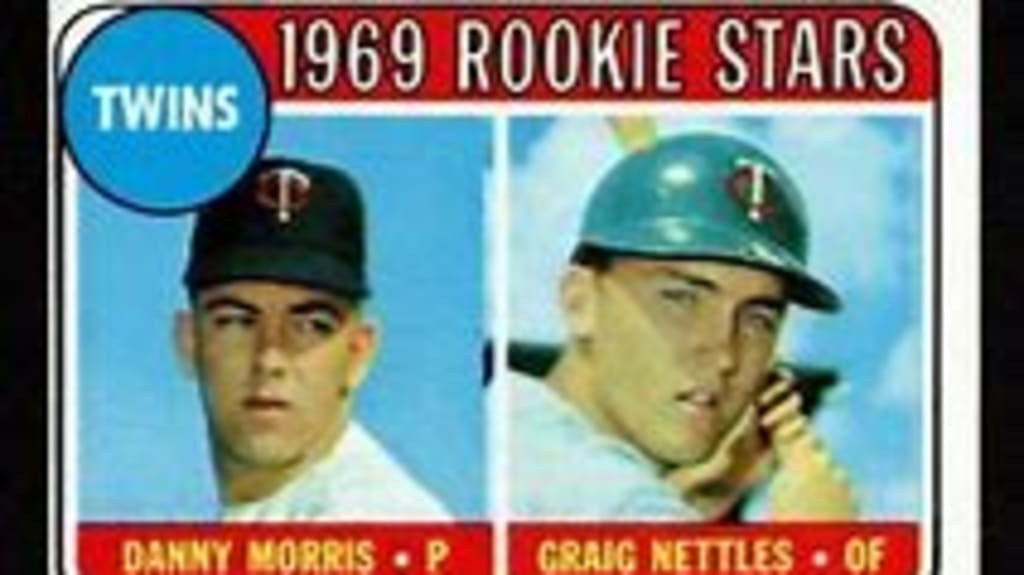
Graig Nettles, 1969 Topps
Nettles spent 11 of his 22 Major League seasons in a Yankees uniform, earning five All-Star selections and two Gold Glove Awards during his time in the Bronx. But while he would go on to play for the Padres, Braves and Expos, Nettles’ career began with the Twins, for whom he made his big league debut in 1967.
The future star third baseman only played in 121 games for Minnesota before being traded to Cleveland and, eventually, New York.
Ed B. submitted this card for our survey, and on it a baby-faced Nettles appears with fellow Twins rookie Danny Morris, a right-handed pitcher who would only appear in six MLB games for Minnesota. -- Manny Randhawa

Harmon Killebrew, 1961 Topps
This card of the Hall of Famer comes from the year the Twins franchise moved to Minnesota. Killebrew hit 46 home runs and collected 122 RBIs that year.
Twins fan Bill Fisher of St. Paul remembers how he was the only kid in town with the card, which makes it his favorite to this day.
"Without a doubt, a 1961 Harmon Killebrew. I was 11, and the only one in my neighborhood to have one," Fisher explains. "I see now that I can buy one now for as little as $9.99, or for as much as $2,850. I got mine for 1 cent, along with a stick of bubble gum."
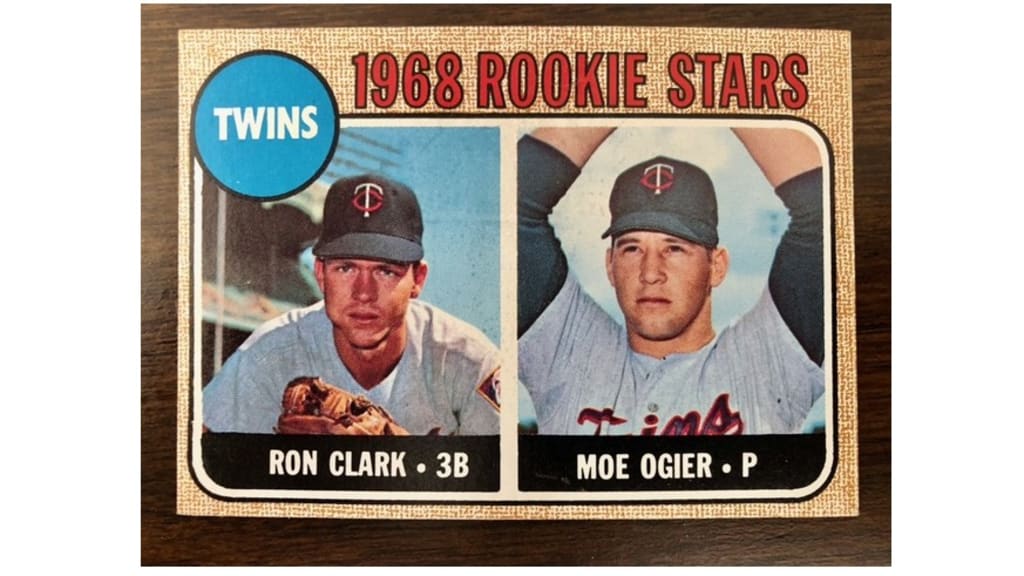
Ron Clark and Moe Ogier, 1968 Topps
Any collector who has gone about the difficult task of trying to complete a set knows the feeling of trying to track down that one last card: the great white whale. The card takes on a special significance, even if it's an otherwise ordinary card.
For Bruce Pelletier of Atkinson, N.H., it was the Clark/Ogier combo rookie card in the ‘68 Topps set. Clark didn’t amount to much in the Majors, and Ogier never even reached MLB, but it's at the top of Pelletier’s list of the most memorable cards.
“In the summer of 1968, at age 12, I pieced together the entire '68 Topps set,” Pelletier wrote. “I had no real problems with the first six series, but in the seventh and final series, I couldn't get my hands on the ‘Ron Clark/Moe Ogier’ rookie card to complete my set, either through purchasing more packs or through trade. Finally, I found someone who would trade it. I paid a hefty price, but obtained it. This is therefore my most memorable card, even through many years of collecting.
“I'd venture to predict that the only people who might find this card more memorable are the Clark and Ogier families.” -- Thomas Harrigan


